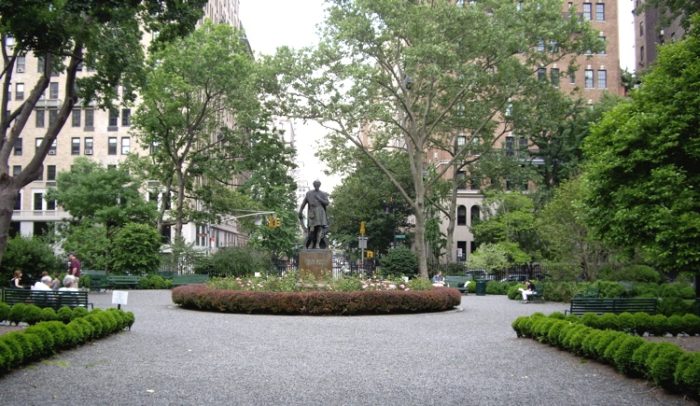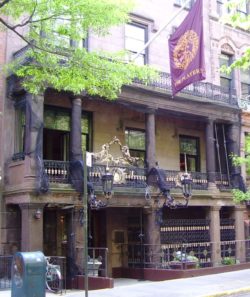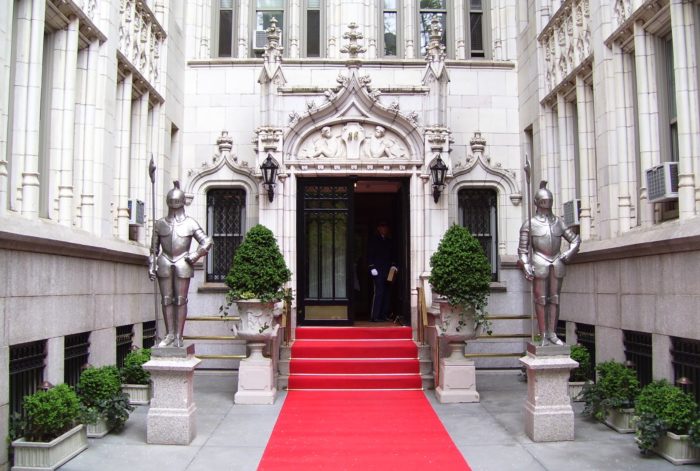The park that gives the Gramercy neighborhood its name is the only private park in Manhattan and one of only three in New York State. Nestled between 20th and 21st Streets, it marks the end of Irving Place and the beginning of Lexington Avenue; if those two streets met, it would be in the center of the park, where the statue of renowned Shakespearean actor Edwin Booth was erected in 1916. The statue was donated by the Players Club, a social club for theater professionals; Booth not only founded the club, but he was also one of the numerous illustrious residents lucky enough to live across the park. In fact, he gave over much of his Gothic Revival residence at 16 Gramercy Place South for the club’s use.
A statue of actor and one-time local Edwin Booth marks the center of Gramercy Park. Image: Dmadeo/Wikimedia
Only owners of the 39 buildings immediately surrounding what was originally called Gramercy Square have keys to the gated park. Access to the park is also a perk of membership in the Players Club and its next-door neighbor the National Arts Club. The latter, located at 15 Gramercy Park South, had been the home of Samuel Tilden. He bought the brownstone in 1860. In 1875 he would become the governor of New York; a year later he would become the first presidential candidate to win the popular vote but not the electoral college. After retiring from politics he had the home refurbished by Calvert Vaux, one of the architects of Central Park. The National Arts Club bought the house in 1906.
The park has been enclosed by a fence since its development in 1833, even though the first brownstones surrounding it were not built until the 1840s.
The private park has long given the buildings around it an air of exclusivity. Even early on, they were the residences of notable figures. For instance, the original owner of 3-4 Gramercy Park West was James Harper, cofounder of the publishing company that became Harper & Row before merging with William Collins to become HarperCollins; he moved there in 1847, two years after completing a term as New York mayor. More than a century later, in 1952, actor John Garfield died in number 3 while visiting a friend who lived there.
Though he did not own one of the brownstones, Thomas Alva Edison and his family did rent an apartment in 24 Gramercy Park South for several years, beginning in 1881. They continued to summer in Menlo Park, NJ, however, where Edison created the phonograph and the incandescent light bulb, among other inventions.
Stanford White added an elaborate portico to 16 Gramercy Place South, the Players Club, after Edwin Booth bought it in 1888. Image: Beyond My Ken/Wikimedia
Another celebrity renter was architect Stanford White, who moved into the neighborhood in 1892, a few years after he renovated 16 Gramercy Park for Edwin Booth. White transformed what was then 121 East 21st Street into a mansion that was extravagant even for that extravagant era. White and his family were living in the treasure trove—its contents included an Italian Renaissance marble fountain, cartoons by Raphael, a carved ceiling that White had removed from a chapel in Florence, and a fireplace from Tudor England—until White’s notorious murder in 1906.
Less than two decades after White’s death, his home and numbers 117 and 119 East 21st Street were razed to make way for the Gramercy Park Hotel. The hotel had several famous residents of its own, in addition to a panoply of celebrity guests. Joseph Kennedy moved his family, including young sons John, Robert, and Ted, into the hotel for several months before they relocated to London, where Kennedy served as U.S. ambassador. Writer Mary McCarthy, best known for the novel “The Group,” and her second husband, critic Edmund Wilson, lived in the hotel in the 1940s. Another writer, humorist and screenwriter S.J. Perelman, died in his apartment in the hotel in 1979. And when actor James Cagney and his wife lived at 34 Gramercy Park East, they regularly dined at the hotel’s restaurant.
John Barrymore, Alfred Ringling, and Daniel Chester French were among the residents of 36 Gramercy Park East. Image: Beyond My Ken/Wikimedia
Other actors who at one time had keys to the park include Drew Barrymore’s grandfather John Barrymore, who lived at number 36 from 1910 to 1916. Among subsequent residents of the same building were sculptor Daniel Chester French, best known for the towering statue of Abraham Lincoln within Washington D.C.’s Lincoln Memorial, and Alfred Ringling of Ringling Brothers Circus fame. The Gothic building is a particular standout due to the two suits of armor that stand guard at its entrance.
And in addition to the Cagneys, Margaret Hamilton, best remembered as the Wicked Witch in “The Wizard of Oz,” owned a residence in number 34. The red-brick building is also notable for being one of the city’s first co-ops. Since 2016, is has been home to yet another actor, Richard Gere. His eighth-floor unit is the one that had been owned by Hamilton—and his “Pretty Woman” co-star Julia Roberts owns a unit in 7 Gramercy Park West.





